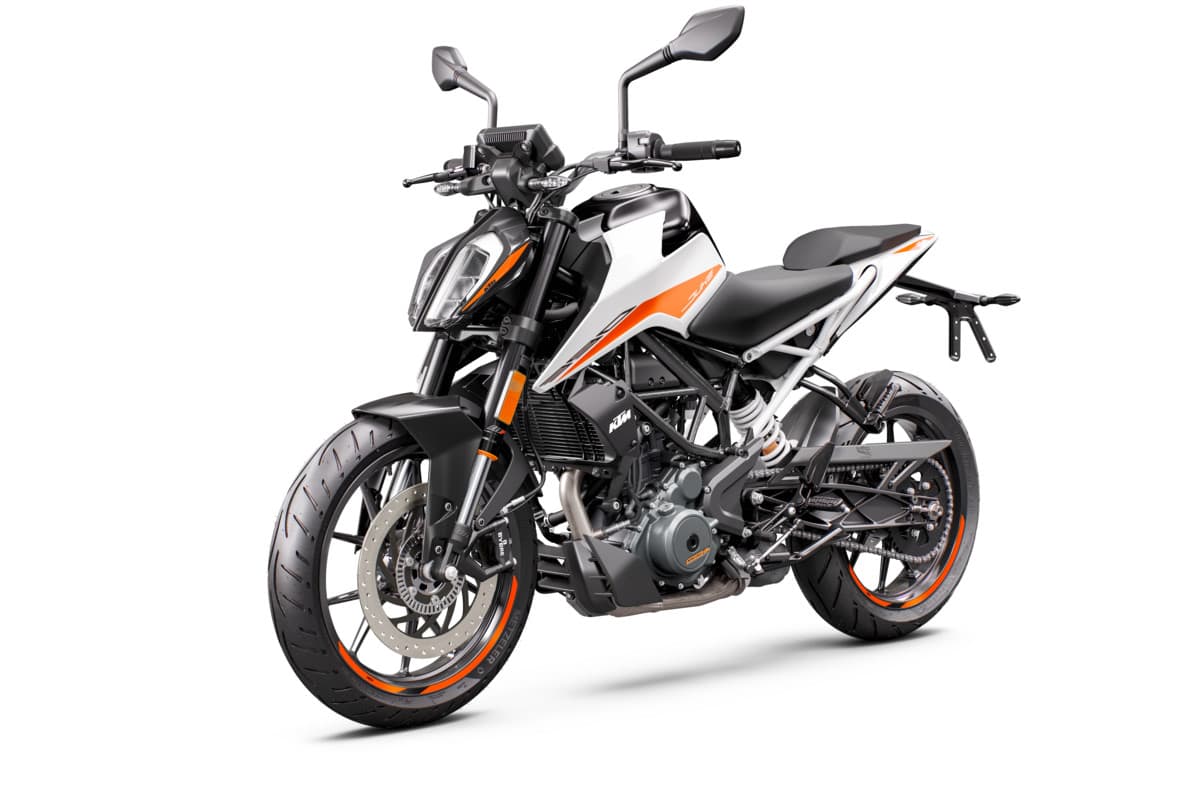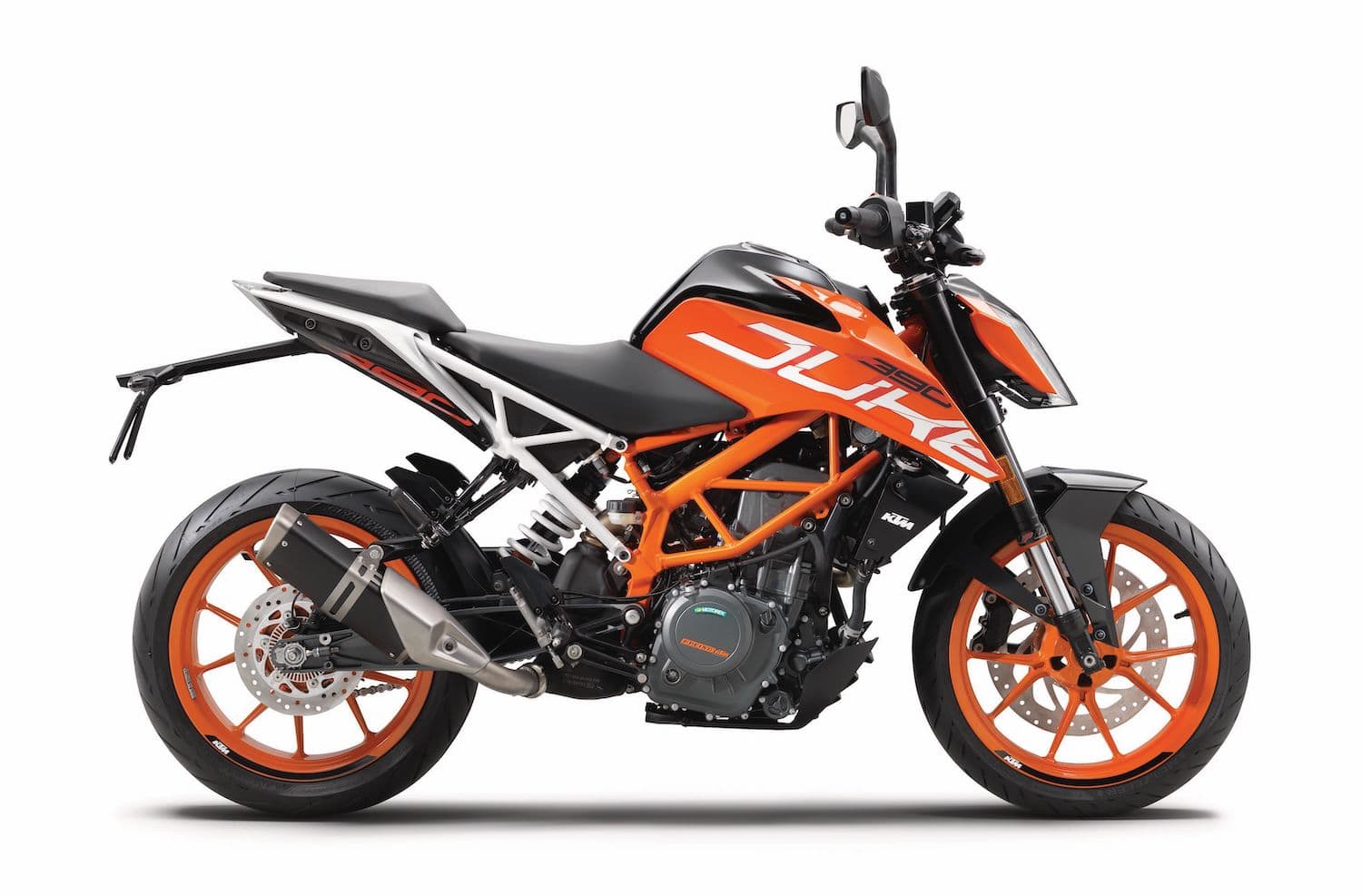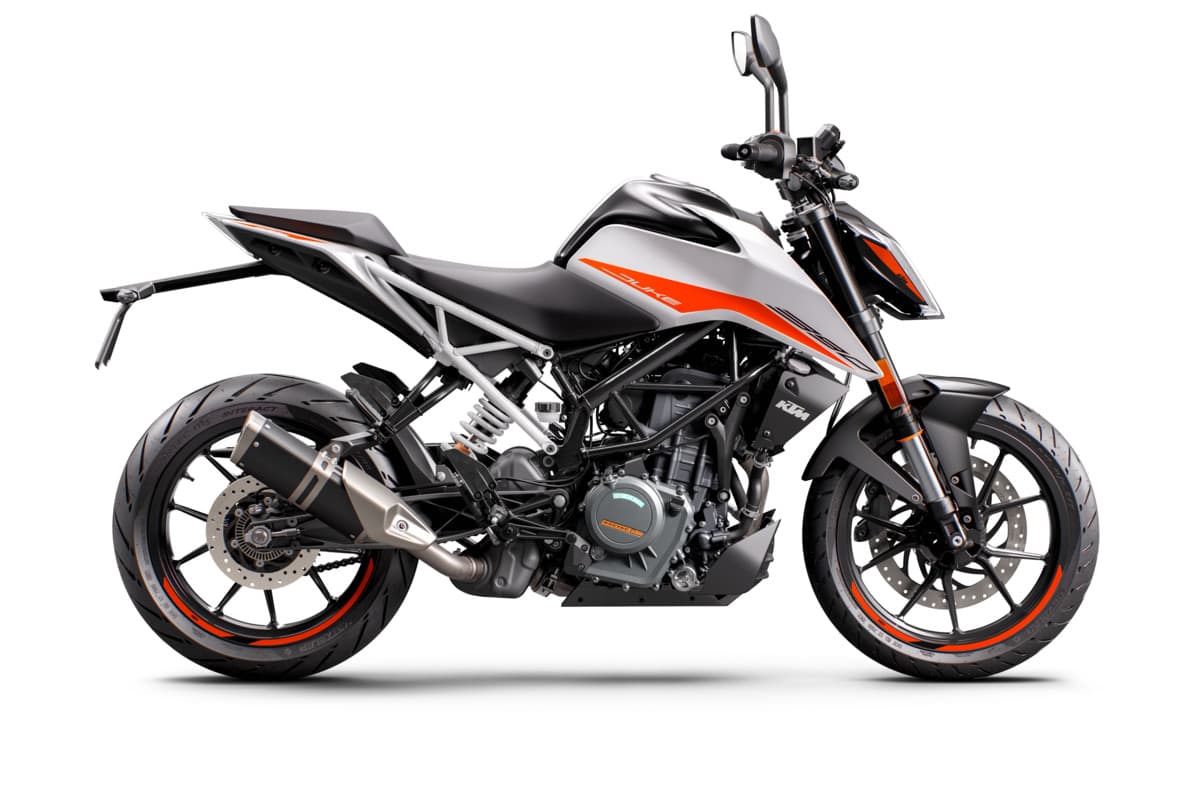KTM 390 Duke (2013-2023) Maintenance Schedule & Service Intervals
Originally published 9 July 2021. Modifications since then: Separate “maintenance checklist”, chain maintenance, tire specs, and more.
This is the maintenance schedule and service intervals for the KTM 390 Duke, KTM’s entry-level roadster.
The KTM 390 Duke uses the same engine block as in the KTM 390 Adventure and KTM RC 390, so the maintenance schedule has a lot in common.
The KTM 390 Duke is powered by a single-cylinder fuel-injected engine that makes peak power of 32 kW (43 hp), with 37 Nm (27 ft-lb) of peak torque.
It was built to compete with other entry-level roadsters like the BMW G 310 R and Honda CB300R.
From 2024, KTM updated the KTM 390 Duke to a larger-capacity 398 cc engine, keeping the name the same. They also widened the service intervals. See its maintenance schedule here.
This site has links for things like oil and spark plugs from which we earn a commission (which unfortunately nobody can save, not even us). If you appreciate this work, then please use those links. Thanks!
KTM 390 Duke Service Intervals
According to the manual, the KTM 390 Duke has relatively short service intervals of 4650 miles or 7500 km, at which point you should change the oil and filter, change the air filter, and do a whole host of checks.
Every two services (every 9300 miles or 15000 km), change the spark plug and check the valve clearances. Luckily, the 390 Duke it’s a naked bike and there’s just one cylinder, so the valve clearance check is not actually too bad.
Finally, the 390 Duke is a liquid-cooled bike, so change the coolant periodically, and keep the brake fluid up to date.
What you need to service your KTM 390 Duke
Servicing your 390 Duke is fairly easy, relatively speaking. It’s a single-cylinder engine with exposed parts. So when the valve service comes up every 15000 km it’s not an overwhelming task.
Aside from basic motorcycle maintenance tools, here’s what you need to service your 390 Duke.
| Part | KTM 390 Duke spec |
|---|---|
| Engine oil | The manual requires SAE 15W-50 oil that meets JASO T903 MA2 spec, and recommends Motorex oils, e.g. Motorex Top Speed 15W-50, a full synthetic. |
| Oil filter | Use a Hiflofiltro HF155 as a high-quality drop-in replacement. |
| Spark plug | Standard spark plug is a Bosch VR 5 NEU. You can also use a LKAR8A-9 per the good people of ktmduke390forum.com. |
| Fork oil | Use SAE 4 fork oil. |
| Air filter | Use a K&N KT-1217 air filter. |
| Brake fluid | Use a DOT 4 fluid e.g. Castrol DOT 4 full synthetic. |
| Coolant | The manual calls for Motorex Coolant M3.0, which is an OAT coolant based on ethylene glycol that’s silicate, nitrite, amine, borate, and phosphate free. (Most coolants contain at least phosphates or silicates… be wary) |
| Clutch cable lube | Use either engine oil or Protect all cable life, an affordable and quality lubricant. |
| Chain maintenance | Use Motul chain paste, a low-mess, high-quality chain lube. The manual recommends the more expensive Motorex chain lube. |
| Grease | Grease external parts with Motorex 2000 long-life lubricant per the manual, or any good lithium soap-based grease. |
Maintenance schedule for the KTM 390 Duke
The schedule below comes straight from the manual for the 390 Duke, though it has been restructured to make it easier to parse.
Like other KTM motorcycles, the 390 Duke’s maintenance schedule is broken up into “required” and “recommended” work. However, the “recommended” work is required by most other brands (e.g. changing the coolant).
To simplify this, we’ve split it into the standard service and the scheduled maintenance table, so you can easily see what to do every service, and what is only done occasionally.
KTM recommends most of the work be done by mechanics, and users only do the following:
- Check brakes (maybe replace if necessary)
- Check/adjust tyre pressures
- Check/adjust chain tension
- Check coolant and brake fluid levels
And very little else. Of course, servicing the 390 Duke isn’t hard as a single-cylinder mostly-naked bike, so it’s up to you.
KTM 390 Duke — Standard Inspection Checklist
Below is the inspection checklist for the KTM 390 Duke. Do this according to the schedule below.
Some items are marked [Dealer] as they need special equipment.
| KTM 390 Duke Standard inspection checklist |
|---|
| [Dealer] Read out the fault memory using the KTM diagnostics tool |
| Check that the electrical system is functioning properly (lights, switches) |
| Check the brake discs Front disc minimum thickness: 4.5mm Rear disc minimum thickness: 3.6mm |
| Check the front brake pads (minimum thickness 1mm / 0.04 in) |
| Check the rear brake pads (minimum thickness 1mm / 0.04 in) |
| Check the brake lines for damage and leakage |
| Check the front brake fluid level (between lines) |
| Check the rear brake fluid level (between lines) |
| Check the tire condition (no damage, cracks) |
| Check tire pressure (see below for tire pressure specs) |
| Check the shock absorber and fork for leaks or damage |
| Check the chain tension (see below for guidance) |
| Check the coolant level |
| Check the antifreeze / antiboil effectiveness (if you have the right equipment) |
| Check that the radiator fan is functioning properly |
| Chek that the throttle cables are undamaged, routed without sharp bends, and set correctly. |
| Check the cables for damage and routing without sharp bends |
| Check the steering head bearing play (ensure ease of movement and no notchiness) |
| Empty the drainage hoses |
| Check all hoses (fuel, coolant, drainage etc.) and sleeves for cracking, leaks, and incorrect routing |
| Grease all moving parts (e.g. side stand, hand lever, chain) and check for smooth operation |
| Check the tightness of the safety-relevant screws and nuts which are easily accessible. |
| Final check: Check the vehicle for safe operation and take a test ride. |
| [Dealer] Read out the error memory after the test ride using the KTM diagnostics tool. |
| [Dealer] Set the service interval display. |
| [Dealer] Make a service entry in KTMDealer.net |
KTM 390 Duke Maintenance Schedule
Below is the scheduled maintenance table for the 390 Duke.
Notes
- Keep following the schedule in the pattern shown.
- Some items have a time-based schedule only (e.g. fluids), some a distance-based schedule only (e.g. valve clearance), but many items have both.
- We’ve simplified some of the interval distances (nobody is going to do a service at exactly 13950 miles, so we put it at 14000 for example)
| mi x 1000 | 0.6 | 4.7 | 9.3 | 14 | 18.6 | |
|---|---|---|---|---|---|---|
| km x 1000 | 1 | 7.5 | 15 | 22.5 | 30 | Every |
| Conduct a standard inspection service (see list above) | ✓ | ✓ | ✓ | ✓ | ✓ | Year |
| Change the engine oil (Motorex Top Speed 15W-50) | ✓ | ✓ | ✓ | ✓ | ✓ | Year |
| Change the oil filter (HF155) | ✓ | ✓ | ✓ | ✓ | ✓ | Year |
| Clean the oil screens | ✓ | ✓ | ✓ | ✓ | ✓ | Year |
| Clean the dust boots of the fork legs | ✓ | ✓ | ✓ | ✓ | ||
| Change the air filter (KT-1217), clean the air filter box. | ✓ | ✓ | ✓ | ✓ | ||
| Check the chain, rear sprocket, and engine sprocket | ✓ | ✓ | ✓ | ✓ | Year | |
| Check the valve clearance, change the spark plug. (Bosch VR5 NEU) Intake: 0.10-0.15 mm / 0.0039-0.0059 in) Exhaust: 0.15-0.20 mm / 0.0059-0.0089 in) | ✓ | ✓ | ||||
| Check the frame (rust, cracks) | ✓ | |||||
| Check the link fork | ✓ | |||||
| Check the fork bearing for play | ✓ | ✓ | ✓ | ✓ | ||
| Check the wheel bearing for play | ✓ | ✓ | ✓ | ✓ | ||
| Change the front brake fluid. (Motorex DOT 5.1, Castrol DOT 4) | 2 years | |||||
| Change the rear brake fluid. (Motorex DOT 5.1, Castrol DOT 4) | 2 years | |||||
| Change the coolant (Motorex Coolant M3.0) | 4 years | |||||
| Check the headlight setting | ✓ | ✓ | ✓ | ✓ | ✓ |
KTM 390 Duke Tyre sizes and pressures
The KTM 390 Duke ships with the following tyre sizes and pressures.
| Wheel | Tyre size | Tyre pressure |
|---|---|---|
| Front | 110/70 R 17 M/C 54H TL | 200 kPa / 2 bar / 29 psi |
| Rear | 150/60 R 17 M/C 66H TL | 200 kPa / 2 bar / 29 psi 220 kPa / 2.2 bar / 32 psi with passenger |
The 390 Duke ships with either Metzeler Sportec MT Interact or Continental ContiMotion tyres stock.
KTM 390 Duke Chain Maintenance
KTM recommends you regularly clean the chain and check / adjust its tension.
To check the tension, you measure the distance between the chain and the link fork. Target chain slack for the KTM 390 Duke is 5-7mm when the top part of the chain is under tension.

To measure tension
- Put the transition into neutral
- Raise the rear wheel
- Press upwards on the chain near the chain guard.
- Measure the distance between the middle of the chain and the link fork.
- Repeat the measurement for various parts of the chain (chain wear can be uneven)
To adjust the chain tension, you need to release the rear axle, slide it forwards or backwards, and then re-tighten it.
- Loosen the rear axle nut.
- Loosen the lock nuts for the adjusters on both sides
- Turn the adjuster bolts to move the axle position. If you’re reducing tension, you may need to physically move the wheel to make sure it’s moving with the adjusters.
- Make sure you turn them the same amounts (checking the reference marks)
- Re-righten the lock nuts (not too tight)
- Tighten the rear axle nut (very tight — 98 Nm / 72 lb-ft)
About the KTM 390 Duke
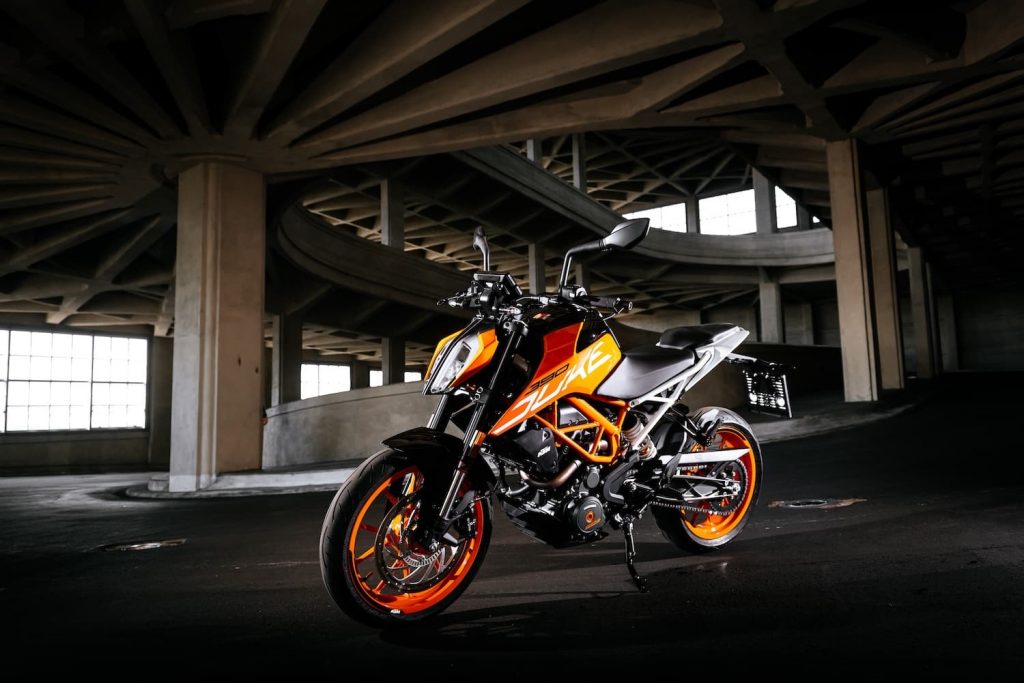
The KTM 390 Duke is an entry-level “roadster” motorcycle from KTM.
Previously mostly known for their dirt bikes and endurance bikes, KTM started making serious headways into the road segment in the mid 2010s.
The KTM 390 series is an attempt to make an affordable, high-quality road bike for people looking for a lower-powered (but still very freeway-capable) bike that can “do it all”.
The 390 range is also a great option for people in Europe or Australia/NZ who have capacity, power, and/or power-to-weight ratio restrictions on provisional licenses.
The KTM 390 Duke sits alongside the race-oriented RC390 and the adventure tourer 390 Adventure. It uses the same base engine, a 373cc single-cylinder fuel-injected engine that makes peak power of 32 kW (43hp) at 9500 rpm, but it makes decent torque from as low as 2500 rpm — so you have no trouble manoeuvring this around town. It’s not a high-strung sportbike.
What makes the 390 Duke distinct from other entry-level bikes is that it pulls quite a bit of power from its single-cylinder engine. This is in part because it’s a higher capacity one, but also because of the higher compression ratio (12.9:1, quite aggressive, requiring 95 RON as a recommendation in the manual — though it works fine with lower RON fuel) and tuning.
Other single-cylinder bikes in the segment make a lot less power. The Honda CB300R makes 23 kW, and the BMW G 310 R makes 25 kW.
The suspension is low in price, but not low in quality. The front forks are WP upside-down forks with no adjustability, and the rear shock is a WP shock with preload adjustment. It’s fine, as long as you’re not too heavy (or way too light).
One of the less-cited facts about the KTM 390 Duke is just how light it is. Fully fuelled it weighs only 146 kg (322 lb). That’s so light! It makes the 390 Duke feel toy-like when you sit on it, easy to throw around like a dirt bike, and very confidence inspiring for new riders or those who feel unsure if they could pick up a heavy bike.
Other bikes may feel light, but you really need a bike to actually be light when you get to situations like dirt roads or trying to back your bike into an awkward parking space. Lightness rules.
The KTM 390 Duke also has a decent amount of tech. The latest models (2019 onward) have a TFT display, receiving this ahead of even the racier KTM RC 390. And it has always come standard with Bosch ABS — another thing making it beginner-friendly.
All in, the 390 Duke is a fun bike, both for people used to high-power sportbikes and wanting a city scratcher, or those just getting started.
Reference: Manual for the KTM 390 Duke
The above maintenance schedule came directly from the manual for the KTM 390 Duke.
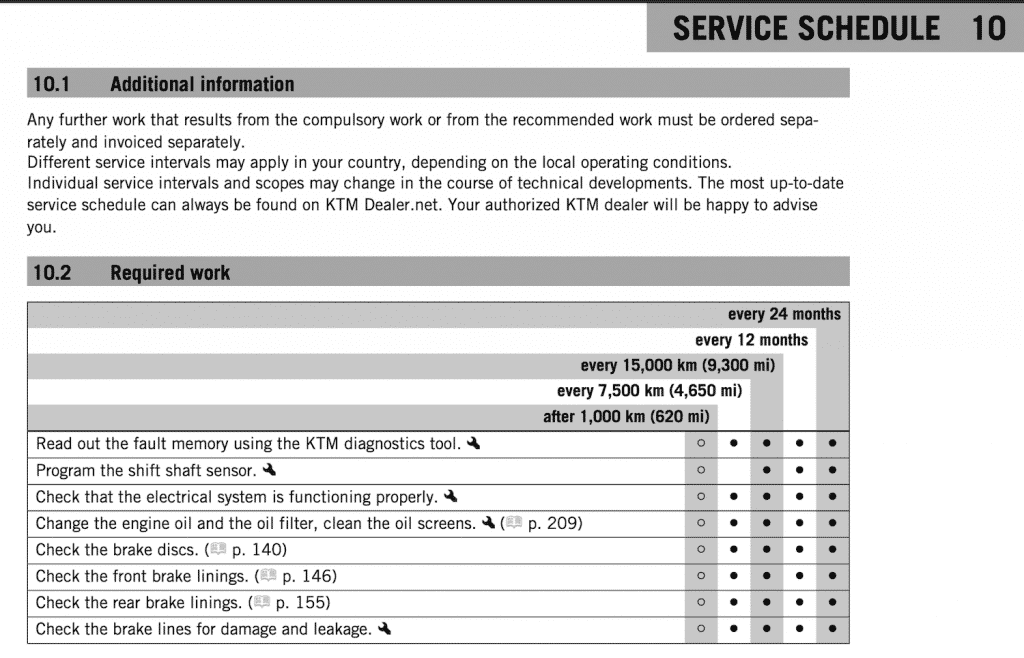
You can download the manual directly from KTM here. An archive copy of the manual is below.






